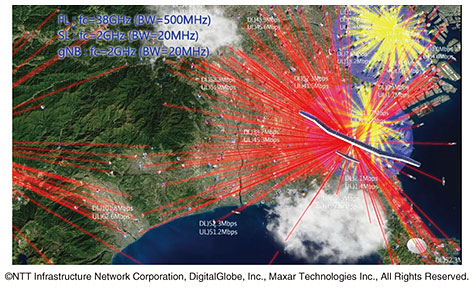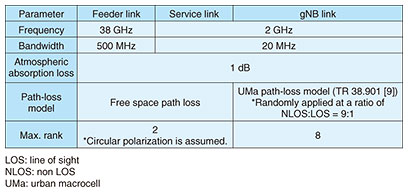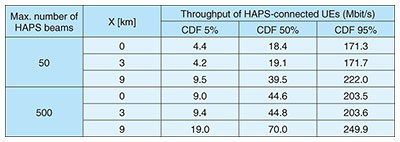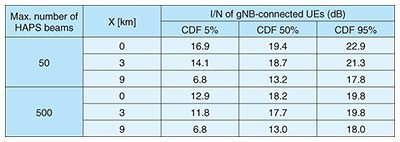 |
|||||||||||||||||||||||||||||||||||||||||||||||
|
|
|||||||||||||||||||||||||||||||||||||||||||||||
|
Feature Articles: Space Integrated Computing Network Vol. 20, No. 12, pp. 28–35, Dec. 2022. https://doi.org/10.53829/ntr202212fa3 Studies toward Practical Application of HAPS in the Space RANAbstractThe space radio access network is regarded as a communication infrastructure for the 5th-generation mobile communication system (5G) Evolution and 6G, and extreme coverage extension is being studied for use cases in all locations including air, sea, and space. For early implementation of extreme coverage extension, we are focusing on low-latency communication services using high-altitude platform stations (HAPSs). In this article, we present use cases and technical issues of wireless system technology with HAPSs and propose a three-dimensional-cell control technology for frequency sharing between a HAPS and terrestrial networks. Keywords: HAPS, Space RAN, extreme coverage extension 1. IntroductionThe space radio access network (Space RAN) is regarded as a communication infrastructure for the 5th-generation mobile communication system (5G) Evolution and 6G, and aims to achieve extreme coverage extension*1 to all locations, including the sky, sea, and space, which have not been sufficiently covered by conventional mobile communication networks, using non-terrestrial networks (NTNs)*2 based on geostationary (GEO) satellites, low Earth orbit (LEO) satellites, and high-altitude platform stations (HAPSs)*3 [1]. For early implementation of extreme coverage extension, we are focusing on low-latency communication services using HAPSs [2]. HAPSs make it easy to extend communication-service coverage to a wider area; thus, making it possible to provide highly reliable communication in times of disaster, high-capacity communication for ships and aircraft, and communication services for distant islands and remote areas. Mobile carriers can improve the overall cost-effectiveness and energy efficiency of their mobile networks by combining HAPSs with an increase in the number of their terrestrial base stations to extend their service coverage. This article describes the efforts toward the practical application of HAPSs in the Space RAN. Specifically, we present use cases and technical issues of wireless system technology with HAPSs and propose a three-dimensional (3D)-cell control technology for frequency sharing between a HAPS and terrestrial networks (TNs).
2. HAPS use cases and network configuration/control technologiesNTT DOCOMO is researching and developing communication methods and network architectures that can flexibly link 5G networks and other TNs with stratospheric HAPS networks [3]. In addition to providing flexible support for a wide range of future use cases as envisioned in 5G Evolution and 6G, this project is conducting studies aimed at the implementation of communication systems that use HAPSs in terms of development and operation costs. 2.1 HAPS use casesAs shown in Fig. 1, for the 5G Evolution and 6G era, it is expected that various use cases will involve using HAPSs to relay radio waves or emit radio waves as a base station. These use cases include fixed systems that provide services for backhaul*4 applications and mobile systems that provide services to terminals either directly or via repeaters and relays. There is a need for flexible communication methods and systems that can support all use cases of fixed and mobile systems.
It is also necessary to flexibly control lines so that they can be adapted from normal business applications to public safety applications in the event of a disaster. Current disaster countermeasures are geared toward providing basic communication services such as voice calls and short message services, but it may also be necessary to consider use cases that require faster communication speeds, such as remote control of equipment at disaster sites, video transmission, and communication via drones. For disaster countermeasures, it will also be necessary to study network configurations and control technologies that assume the ability of a system to operate even if certain devices become unavailable. 2.2 Cooperative network configuration and control technology for HAPSs and TNs2.2.1 Classification of HAPS-mounted stationsRegarding the network configuration and control technology used when implementing backhauls to 5G base stations via HAPSs, we are focusing on the categorization of HAPS-mounted stations. They can be roughly divided into two types: (1) relay stations, which receive signals from ground stations and relay them back to other ground stations after executing necessary processes such as frequency conversion, and (2) base stations, which are made by installing 5G network base-station equipment (or at least part of it) in a HAPS [4]. The relay type is effective when the number of onboard devices is relatively small and the size, weight, and power consumption of the HAPS-mounted station are strictly limited. The base-station type is formed by equipping a HAPS with an antenna device, together with many base-station functions. The more of these functions it includes, the greater the amount of control that can be executed within the HAPS, making it possible to reduce the amount of feeder-link information. However, installing more functions results in a station that is larger, heavier, and consumes more power. Implementing more base-station functions on the ground-network side has the advantages of lower development costs and ease of operation, but implementing these functions on the HAPS results in greater resilience to natural disasters. In terms of performance, a HAPS-mounted station should at least implement certain functions, such as beam control, when using millimeter waves. It is also necessary to comprehensively study a wide range of requirements to be considered when incorporating HAPS systems into a 5G network. These include the size, weight, and power consumption of HAPS-equipped stations, their development and operation costs, the ability of these HAPS platforms to be shared by backhaul use and direct-to-device communication systems, and their ability to cooperate with GEO/LEO satellites. 2.2.2 Examples of network configuration in conjunction with the 5G networkAn example of a HAPS base station in a network configuration linked to the 5G network is shown in Fig. 2. The distributed unit (DU) and radio unit (RU) of the 5G base station are mounted on the HAPS in accordance with Open RAN (O-RAN) ALLIANCE specifications [5]. In this configuration, availability is ensured by installing a centralized unit (CU) at a disaster-resistant point on the ground. Information received by the HAPS from the CU in the feeder link is transmitted via 5G radio to a small terrestrial base-station device (relay station) in the service link, enabling the use of portable 5G base stations without having to use a wired backhaul. In this configuration, it is also possible to provide direct communication from the HAPS to 5G terminals without the need for intervening relay stations. As a further extension, site diversity*5 can be implemented using multiple CUs on the ground side to reduce the impact of bad weather and natural disasters, and mobility support*6 can be implemented by switching the communication target to a different HAPS when the terminal moves from one communication area to another.
Another promising configuration using a relay-type configuration where a 5G radio repeater is installed in a HAPS is shown in Fig. 3. In this configuration, the TN is used from the core network to the fronthaul*7, and the HAPS terrestrial system equipped with the RU function bundles and communicates signals for multiple beams. A broadband frequency, such as the Q-band, is used in the feeder link*8, and the HAPS relay system executes frequency conversion and power control. The HAPS can then establish service-link*9 communications using multiple beams at the same time. As the service link, certain frequency bands below 2.7 GHz already identified for International Mobile Telecommunications (IMT) should be used according to the specifications approved at the World Radiocommunication Conference 2019 (WRC-19) [6] and the agenda item for WRC-23 [7].
In addition to the configurations shown in Figs. 2 and 3, we consider other promising configurations in which a HAPS is used to carry a standalone*10 5G base station. For each configuration, it is necessary to conduct a comprehensive study that takes into account various attributes such as mobility support, site diversity technology, frequency-sharing technology*11, and HAPS installation requirements such as links with GEO/LEO satellites, the equipment weight, and power consumption.
3. 3D-cell control technology for frequency sharing between a HAPS and TNsFor mobile applications in which general user equipment (UE) communicates directly with HAPS base stations, the use of frequency bands below 2.7 GHz specified for IMT is being discussed as International Telecommunication Union (ITU) agenda item 1.4 at WRC-23 [8]. By sharing the same frequency between a HAPS and a TN, sets of UEs connected to the terrestrial IMT network can directly connect to the HAPS and conserve frequency resources. In this section, we present our proposed 3D-cell control technology that avoids interference between a HAPS and TNs. We also present a HAPS-performance evaluation in the 2-GHz band using the 6G system-level simulator developed as a stepping stone for actualizing HAPS technology. 3.1 Evaluation of interference avoidance in the 2-GHz band using 3D-cell control technology3.1.1 3D-cell control technologyOur 3D-cell control technology suppresses the intersystem interference between a HAPS and TNs. As shown in Fig. 4, the HAPS suppresses the intersystem interference and achieves load balancing by not directing the beam to the distance threshold X [km] around the terrestrial next-generation NodeB (gNB) (hereafter, X denotes gNB connection threshold).
3.1.2 Simulation conditionsWe assumed a scenario in which the HAPS service link and terrestrial gNB link share the 2-GHz band, as shown in Fig. 5. The HAPS simulator was used to evaluate the interference avoidance of the 3D-cell control technology. Table 1 lists the system-related parameters and Table 2 lists the simulation parameters for each device. The layout of each device is shown in Fig. 5. As an initial evaluation, two Earth stations, two HAPSs, 500 UEs, and two terrestrial gNBs were placed in an area of approximately 60 × 114 km that includes Tokyo, Japan. The two terrestrial gNBs were placed near Tokyo, and UEs were randomly placed at a ratio based on population distribution.
3.1.3 Simulation resultsThe values of the cumulative distribution function (CDF) at 5, 50, and 95% for the throughput for all UEs when X was changed are listed in Table 3. We confirmed that load balancing worked as X increased and the average throughput for all UEs improved in the downlink. If X increases to 9 km, the number of UEs with low received power of the desired wave increases, and the throughput deteriorates because even UEs at a point far from the terrestrial gNB are connected to it. When comparing the maximum number of HAPS beams, the throughput for all UEs was higher when the number of beams was 500 than when it was 50. This is because each HAPS-connected UE can select the optimal HAPS beam that yields the maximum gain.
The values of CDF at 5, 50, and 95% in the interference-to-noise ratio (I/N) of gNB-connected UEs when X was changed are listed in Table 4. The I/N decreased as X increased, so the interference avoidance effects could be confirmed. When comparing the maximum number of HAPS beams, the I/N in the downlink was higher when the number of beams was 50 than when it was 500. This is because the smaller the number of beams, the larger the transmission power per beam of a HAPS.
The same evaluation was conducted on the uplink, and load balancing and interference avoidance effects were confirmed as on the downlink. It is necessary to select an appropriate X considering that the coverage area of a HAPS decreases with the increase in X. 4. ConclusionAs part of our efforts to make HAPSs practical in the Space RAN, we presented use cases and technical issues with wireless system technology with HAPSs and proposed a 3D-cell control technology for frequency sharing between a HAPS and TNs. NTT DOCOMO will continue developing NTN technology aimed at achieving extreme coverage extension and technology for HAPS networks and promoting demonstration experiments and standardization activities. Part of this research and development was carried out by the Ministry of Internal Affairs and Communications (Research and Development for Expansion of Radio Resources; JPJ000254). References
|
|||||||||||||||||||||||||||||||||||||||||||||||




















